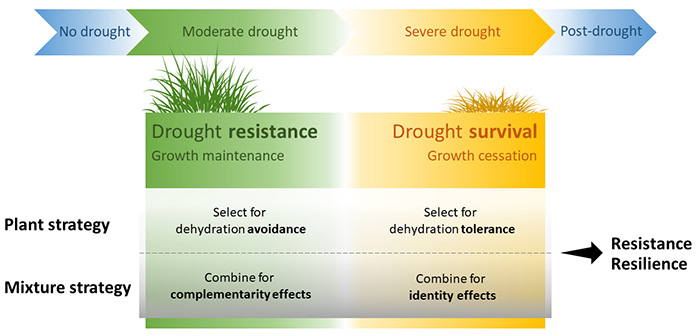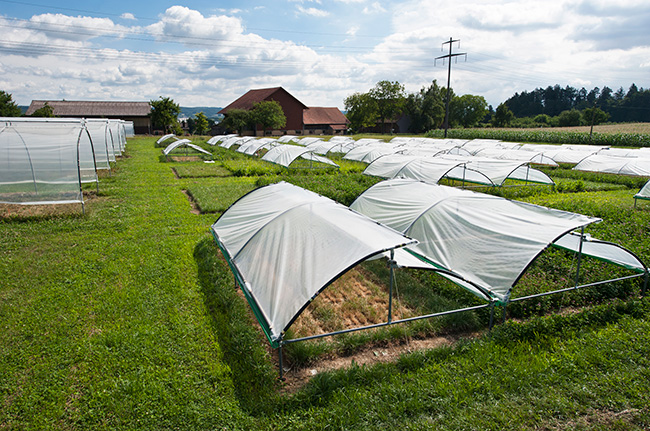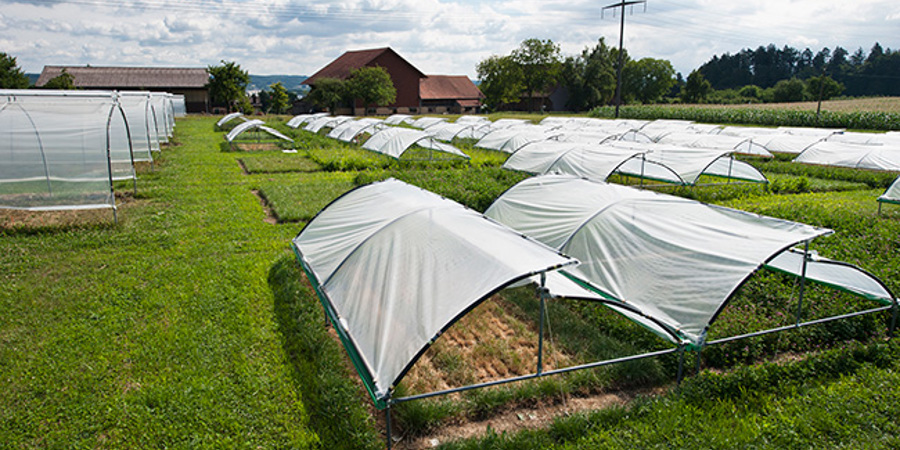Using plant diversity to reduce vulnerability and increase drought resilience of permanent and sown productive grasslands
Research demonstrates that diverse forage mixtures on sown grasslands can lead to higher (or at least equal) yields than less diverse mixtures or monocultures under experimentally-imposed drought conditions across Europe.
Grass and Forage Science’s ‘Editor’s Choice’
In a recent volume of Grass and Forage Science, a review article by Forage grassland’s Innovation Hub leader Andreas Lüscher and co-authors has been awarded ‘Editor’s choice’.
Providing resilience in warming climate
The article looked at how plant diversity can make productive grasslands less vulnerable in the face of climate change, which causes droughts across Europe with increasing intensity and frequency. The drought events may be different from north to south, but the impact on semi-natural and sown productive grasslands can be devastating in all scenarios.
Lüscher and his co-authors explore how changes in species and genotype composition, as well as their diversity, can mitigate adverse drought impacts on sown and permanent grasslands.
Adaptations for climate regions
The review considers a range of drought stresses, from severe and predictable in Mediterranean climates, to moderate and less predictable in temperate to cool climates, suggesting that a whole range of strategies are needed, adapted region by region.
How different plant types cope in different drought scenarios
Plants have two major strategies to respond to moderate and severe drought conditions. First, ‘drought resistance’, i.e., the maintenance of leaf growth and biomass production. Second, ‘drought survival’, i.e., the ability to survive after growth stops due to severe life-threatening drought (see A unified framework of plant adaptive strategies to drought, Volaire, 2018). The former, drought resistance, is more relevant under moderate drought conditions, while drought survival is key under severe drought stress.

Depending on drought stress intensity, diverse strategies can be used to increase grassland resistance and resilience. Figure from Lüscher et al. (2022)
Based on this general principle the authors deduced that:
i) under severe stress, combining species with distinct identities for high dehydration tolerance seems promising; while
ii) under moderate stress, combining species with high dehydration avoidance should be the preferred strategy.
Adapting plant types for the future
Severe conditions
To adapt grasslands to severe drought stress (i), substantial intra-specific (genetic) variability exists in key forage grasses originating from the Mediterranean to the cool-temperate climates and represents a great potential for adaptation of future ecotypes and cultivars to a larger range of drought intensities.
Moderate conditions
To adapt grasslands to moderate drought stress (ii), plant species diversity offers an opportunity to stabilise forage production in two ways.
First, in diverse plant communities, total biomass production is less affected by drought stress than in simple plant communities because the former offers the opportunity to include drought-resistant (or drought-surviving) species.
It has been shown that, under experimentally-imposed drought, species diversity enhanced yield stability (see Higher species richness enhances yield stability in intensively managed grasslands with experimental disturbance, Haughey et al., 2018), reflecting the ‘insurance effects’ of diversity (see Economic benefits from plant species diversity in intensively managed grasslands, Schaub et al., 2020) through reduced temporal variance or mean-to-variance ratio.
Second, in diverse plant communities, positive interactions among species enhance ecosystem functioning, allowing them to compensate for drought-induced yield reductions. Thus, under experimentally-imposed drought, more diverse forage mixtures were associated with higher (or at least equal) yield than less diverse mixtures or monocultures (overyielding, see Yield of temperate forage grassland species, Hofer et al., 2016), reflecting that positive complementarity effects on biomass production also occur under drought.

Experimentally-imposed drought with rain-out shelters on a field site at Agroscope, Zürich, Switzerland. The experiment was set up to explore the effects of plant species diversity to stabilize forage grassland yield under drought. Photo: Agroscope.
We should be valuing and adopting drought strategies that increase resilience
Currently, available cultivars (reflecting intra-specific variability) of perennial forage species adapted to dry climate are still rare and only a few adapted forage species are used in productive systems.
Also, it seems only a small part of the inter-specific variability with respect to moisture conditions is used in sown grasslands today. So while the choice of a successful strategy to adapt to drought strongly depends on the intensity of stress, both intra- and inter-specific plant diversity should be better valued to reduce vulnerability and increase resilience of productive grasslands.
Find out more
Read the full article Using plant diversity to reduce vulnerability and increase drought resilience of permanent and sown productive grasslands (published in Grass and Forage Science, Volume 77, Issue 4, p235-246 in August 2022).
The full article was an adapted version from a keynote presentation at the 29th General Meeting of the European Grassland Federation hosted by France in 2022 (www.europeangrassland.org/) and has recently also been published in Fourrages (Lüscher et al., 2023).
Full list of references
Haughey E, Suter M, Hofer D, Hoekstra NJ, McElwain JC, Lüscher A, Finn JA (2018) Higher species richness enhances yield stability in intensively managed grasslands with experimental disturbance. Scientific Reports, 8, 15047. https://doi.org/10.1038/s41598-018-33262-9
Hofer D, Suter M, Haughey E, Finn JA, Hoekstra NJ, Buchmann N, Lüscher A (2016) Yield of temperate forage grassland species is either largely resistant or resilient to experimental summer drought. Journal of Applied Ecology, 53, 1023-1034. https://doi.org/10.1111/1365-2664.12694
Lüscher A, Barkaoui K, Finn JA, Suter D, Suter M, Volaire F (2022) Using plant diversity to reduce vulnerability and increase drought resilience of permanent and sown productive grasslands. Grass and Forage Science, 77, 235-246. https://doi.org/10.1111/gfs.12578
Lüscher A, Barkaoui K, Finn JA, Suter D, Suter M, Volaire F (2023) Utilisation de la diversité végétale pour réduire la vulnérabilité et accroître la résilience à la sécheresse des prairies productives permanentes et semées. Fourrages 253, 61-74.
Schaub S, Buchmann N, Lüscher A, Finger R (2020) Economic benefits from plant species diversity in intensively managed grasslands. Ecological Economics, 168, 106488. https://doi.org/10.1016/j.ecolecon.2019.106488
Volaire F (2018). A unified framework of plant adaptive strategies to drought: Crossing scales and disciplines. Global Change Biology, 24, 2929-2938. https://doi.org/10.1111/gcb.14062




